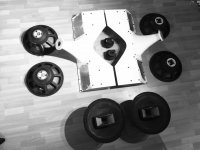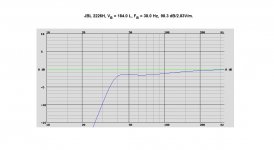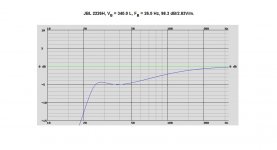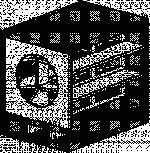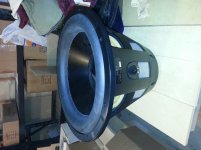Processing will be Ashly Protea
looking to build a mid bass cab, I can also use a 12" 2206H or other 12" driver..
2226 is for 25-100hz
midbass,, 100-800
2441 is planned for 800hz
2405, 8000 and up
The amps will be mostly Ashly FET and some Crown for now
looking to build a mid bass cab, I can also use a 12" 2206H or other 12" driver..
2226 is for 25-100hz
midbass,, 100-800
2441 is planned for 800hz
2405, 8000 and up
The amps will be mostly Ashly FET and some Crown for now
Attachments
JBL 2226H (-5dB@25Hz), tunning in a OPR/EBS type, in reality -3dB@25Hz from "shelf" reference (96/97dB) and will require a big cabinet VB = 184 L, FB = 38 Hz.
Audio Innovation - by Dan Marx www.danmarx.org
Audio Innovation - by Dan Marx www.danmarx.org
Yes, you are right, -5dB@~35Hz. The driver doesn't afford to go that low with that alignment, only possible in a super large enclosure as an example VB = 340.0 L, FB = 26.0 Hz.Inductor, please explain more thoroughly. -5dB @ 25 from a 2226 is a pretty big stretch.
Attachments
almight sub woof.
System design
The prime design goals of a subwoofer are quite clear: The frequency response should be flat from at least 20 Hz up to 100-150 Hz where it will cross over to the main system. It should be able to produce sufficient SPL levels at any frequency in its working range and possess low distortion and colouration. Further the system must have reasonable efficiency, and may not be excessively large. Let's see how these target parameters are met in the system presented here.
I set the maximum enclosure volume to 200 liters (it later proved to have an acoustic volume of ca. 220 liters), and some limits on the proportions. The height should not be greater than allowing placement of a midrange/tweeter system on top, and the depth not more than 90 cm. An enclosure of this size is indeed large, but not beyond acceptable limits in my opinion.
I had already decided what box type to use, but let's just look at the different alternatives. A horn with 20 Hz cut-off is absolutely not possible within my size restriction. Open baffle systems require enormous cone areas to produce any usable SPL because of the massive acoustic cancellation from the driver's rear side, unless the baffle is of infinite size. Let's jump over that too. More commonly utilized acoustic loading are closed box, vented box, bandpass and various passive radiator systems. Let's eliminate the passive radiators first of cost reasons. A15-inch or preferably larger passive radiator of high quality is not at all inexpensive. Bandbass boxes leaves very little flexibility in choosing upper crossover frequency, and they are prone to sound rather honky. A closed box in general may have 6 dB lower sensitivity and a dramatic 10 dB less linear SPL capacity than a vented box. A closed box of the same volume as used here with the same driver have 13 dB less maximum SPL at 22 Hz, and 10 dB less at 30 Hz! This explains in part why closed box subwoofers don't work particularly well. Obviously, vented box is my choice.
A vented system's cut-off rate is very high, usually 4th order (24 dB/octave), which make the response fall off rapidly below cut-off, which happens somewhere near the tuning frequency. Tuning the vented box at a too high frequency will not allow the system to be equalized flat to 20 Hz. In addition, the driver's cone excursion greatly increases below the tuning frequency, and the distortion increases tenfolds (!). Going in the other direction, a low tuning frequency will decrease the system's sensitivity, and require greater cone excursion above the tuning frequency, also reducing the maximum linear SPL capacity.
I found tuning at 24 Hz to be an acceptable compromize. The important 40-100 Hz range shows very satisfying efficiency, and it is still possible to equalize the system flat to 20 Hz without disasterous results regarding cone excursion or input power requirements. With the system equalized flat, the cone excursion for a given SPL remains almost constant over the octave span from 45 Hz down to 22 Hz. This is remarkable indeed. A closed box would show a 12 dB/octave increase in cone excursion, causing the cone excursion to increase a dramatic four times from 45 to 22 Hz.
My desires for 110 dB output without exeeding 1/2 of driver Xmax are very close to being satisfied down to about 22 Hz. The linear SPL capacity is greater than 115 dB above 22 Hz.
The dotted red line on this graph shows SPL with cone excursion at 1/2 of Xmax, limited by maximum input power (600W):
The dotted red line on the graph shows SPL with cone excursion at Xmax, limited by maximum input power (600W):
Damage limited SPL (at 40 mm peak-to-peak cone excursion) is impressing, see the graph below. I've set the input power to 4000W in this simulation, and I'm quite convinced that the driver can survive this power in short peaks. Power compression and other effects will certainly reduce the real output, but this simulation is no matter what very convincing. In other words; headroom in normal applications is no problem.
The simulation of the acoustic response of the unequalized system does'nt look like a subwoofer at all (the red line on the image below). I chose to try equalizing the system flat (OK, it's -2 dB) to 20 Hz, even if the cone excursion and distortion starts to run wild below 22 Hz. First I added a 2nd order high-pass filter at 16 Hz with a Q of 1.3. This filter will, in addition to flatten the response, effectively cut off subsonic input below 16 Hz. The response now looks like the blue line. The next task is to get rid of the rise above 40 Hz. I do this by adding a 1st order filter at 60 Hz. This response resulting from this, the black line, falls off smoothly above 100 Hz. Since I cross over at 100 Hz, this only means I get a steeper cut-off. Crossing at 150 Hz would only require an adjustment of the filter Q. I'll get back to the filter later in this article.
JBL 2226G at 2.83V input (1W @ 8ohms)
2226H (8ohm) will produce 3 dB less output at 2.83V input and 2226J (16 ohm) will produce 6 dB less ouput.
Note: All simulations shown in this article are using half-space free-field acoustic conditions.
System design
The prime design goals of a subwoofer are quite clear: The frequency response should be flat from at least 20 Hz up to 100-150 Hz where it will cross over to the main system. It should be able to produce sufficient SPL levels at any frequency in its working range and possess low distortion and colouration. Further the system must have reasonable efficiency, and may not be excessively large. Let's see how these target parameters are met in the system presented here.
I set the maximum enclosure volume to 200 liters (it later proved to have an acoustic volume of ca. 220 liters), and some limits on the proportions. The height should not be greater than allowing placement of a midrange/tweeter system on top, and the depth not more than 90 cm. An enclosure of this size is indeed large, but not beyond acceptable limits in my opinion.
I had already decided what box type to use, but let's just look at the different alternatives. A horn with 20 Hz cut-off is absolutely not possible within my size restriction. Open baffle systems require enormous cone areas to produce any usable SPL because of the massive acoustic cancellation from the driver's rear side, unless the baffle is of infinite size. Let's jump over that too. More commonly utilized acoustic loading are closed box, vented box, bandpass and various passive radiator systems. Let's eliminate the passive radiators first of cost reasons. A15-inch or preferably larger passive radiator of high quality is not at all inexpensive. Bandbass boxes leaves very little flexibility in choosing upper crossover frequency, and they are prone to sound rather honky. A closed box in general may have 6 dB lower sensitivity and a dramatic 10 dB less linear SPL capacity than a vented box. A closed box of the same volume as used here with the same driver have 13 dB less maximum SPL at 22 Hz, and 10 dB less at 30 Hz! This explains in part why closed box subwoofers don't work particularly well. Obviously, vented box is my choice.
A vented system's cut-off rate is very high, usually 4th order (24 dB/octave), which make the response fall off rapidly below cut-off, which happens somewhere near the tuning frequency. Tuning the vented box at a too high frequency will not allow the system to be equalized flat to 20 Hz. In addition, the driver's cone excursion greatly increases below the tuning frequency, and the distortion increases tenfolds (!). Going in the other direction, a low tuning frequency will decrease the system's sensitivity, and require greater cone excursion above the tuning frequency, also reducing the maximum linear SPL capacity.
I found tuning at 24 Hz to be an acceptable compromize. The important 40-100 Hz range shows very satisfying efficiency, and it is still possible to equalize the system flat to 20 Hz without disasterous results regarding cone excursion or input power requirements. With the system equalized flat, the cone excursion for a given SPL remains almost constant over the octave span from 45 Hz down to 22 Hz. This is remarkable indeed. A closed box would show a 12 dB/octave increase in cone excursion, causing the cone excursion to increase a dramatic four times from 45 to 22 Hz.
My desires for 110 dB output without exeeding 1/2 of driver Xmax are very close to being satisfied down to about 22 Hz. The linear SPL capacity is greater than 115 dB above 22 Hz.
The dotted red line on this graph shows SPL with cone excursion at 1/2 of Xmax, limited by maximum input power (600W):
The dotted red line on the graph shows SPL with cone excursion at Xmax, limited by maximum input power (600W):
Damage limited SPL (at 40 mm peak-to-peak cone excursion) is impressing, see the graph below. I've set the input power to 4000W in this simulation, and I'm quite convinced that the driver can survive this power in short peaks. Power compression and other effects will certainly reduce the real output, but this simulation is no matter what very convincing. In other words; headroom in normal applications is no problem.
The simulation of the acoustic response of the unequalized system does'nt look like a subwoofer at all (the red line on the image below). I chose to try equalizing the system flat (OK, it's -2 dB) to 20 Hz, even if the cone excursion and distortion starts to run wild below 22 Hz. First I added a 2nd order high-pass filter at 16 Hz with a Q of 1.3. This filter will, in addition to flatten the response, effectively cut off subsonic input below 16 Hz. The response now looks like the blue line. The next task is to get rid of the rise above 40 Hz. I do this by adding a 1st order filter at 60 Hz. This response resulting from this, the black line, falls off smoothly above 100 Hz. Since I cross over at 100 Hz, this only means I get a steeper cut-off. Crossing at 150 Hz would only require an adjustment of the filter Q. I'll get back to the filter later in this article.
JBL 2226G at 2.83V input (1W @ 8ohms)
2226H (8ohm) will produce 3 dB less output at 2.83V input and 2226J (16 ohm) will produce 6 dB less ouput.
Note: All simulations shown in this article are using half-space free-field acoustic conditions.
Attachments
I've just simulated it myself. The deep tuning costs you above the tuning f. You reach the full Xmax of 7,6mm (WinISD database) at 189W at 33-42Hz, which results in 112dB. The honestly calculated the Xmax is (winding depth - magnetic gap depth) / 2 wich results in +/-5,475mm Xmax btw.
This is an insane project. OTOH I like stuff like that !
If you take room gain into account EQing it to fully flat down low is probabl not even necessary.
I am currently listening to two-ways with JBL 2206 woofers in boxes arouf 50 liters and a tuning slightly below 40 Hz. They are EQed flat in the active crossover. I first feared that they won't be loud enough above the tuning frequnecy but they can reach pretty insane levels with ease.
Regards
Charles
If you take room gain into account EQing it to fully flat down low is probabl not even necessary.
I am currently listening to two-ways with JBL 2206 woofers in boxes arouf 50 liters and a tuning slightly below 40 Hz. They are EQed flat in the active crossover. I first feared that they won't be loud enough above the tuning frequnecy but they can reach pretty insane levels with ease.
Regards
Charles
I guess your mistake from first posting.Processing will be Ashly Protea
looking to build a mid bass cab, I can also use a 12" 2206H or other 12" driver..
2226 is for 25-100hz
midbass,, 100-800
...
15" JBL 2235H is very fine/capable not 2226H.
Components - 2235H
In reality it's the adequate driver for the job... together with 18" JBL 2245H.
Components - 2245H
Charles, don't know where your located, but our Toronto shop PA system is rather similar to your project. We started building a second pair this week with the similar drivers. We based the upper end design and crossover on the 4350 studio monitor. We have a small manufacturing unit maybe 2500 square feet, 4 of them fill it just fine......... We don't need maximum SPL
2245 x 2 per side - bass reflex ( total of 8 of 18 inch when all 4 boxes are finished)
2202 lo- mid
2441/ 2395 hi-mid
2405
We don't drive them with anything interesting yet, but I have an updated SAE 2700 eq and a Krell KSA 250 at a friend's waiting to be transplanted into driving them.
Mclsound - did you work at Straight Gain electronics in the 80s?
2245 x 2 per side - bass reflex ( total of 8 of 18 inch when all 4 boxes are finished)
2202 lo- mid
2441/ 2395 hi-mid
2405
We don't drive them with anything interesting yet, but I have an updated SAE 2700 eq and a Krell KSA 250 at a friend's waiting to be transplanted into driving them.
Mclsound - did you work at Straight Gain electronics in the 80s?
Last edited:
Amazing! I Would like to visit one day 
Charles, don't know where your located, but our Toronto shop PA system is rather similar to your project. We started building a second pair this week with the similar drivers. We based the upper end design and crossover on the 4350 studio monitor. We have a small manufacturing unit maybe 2500 square feet, 4 of them fill it just fine......... We don't need maximum SPL
2245 x 2 per side - bass reflex ( total of 8 of 18 inch when all 4 boxes are finished)
2202 lo- mid
2441/ 2395 hi-mid
2405
We don't drive them with anything interesting yet, but I have an updated SAE 2700 eq and a Krell KSA 250 at a friend's waiting to be transplanted into driving them.
Mclsound - did you work at Straight Gain electronics in the 80s?
- Status
- This old topic is closed. If you want to reopen this topic, contact a moderator using the "Report Post" button.
- Home
- Loudspeakers
- Multi-Way
- 4 way, 2226H, 2235H, 2395/2441, 2045
